
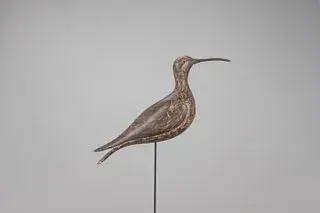

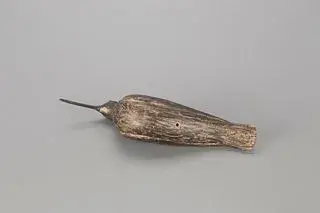
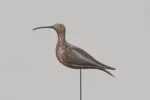
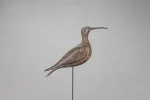

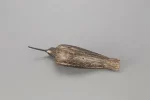
The Harmon Hollow Nantucket Curlew Decoy
Winning Bid: $190,000
The Harmon Hollow Nantucket Curlew Decoy:
The Harmon Hollow Nantucket Curlew
Nantucket, MA, c. 1850
16 in. long
A featherlight, hollow curlew with extraordinary carving and construction detail by a great yet to be named Nantucket craftsman. This decoy has no species specific comparables, with only a few plover by the maker known to have survived in any condition. The design, execution, and refinement of this form place it in the ranks of the best shorebirds by A. Elmer Crowell (1862-1952), Fred Nichols (1854-1924), Charles Sumner Bunn (1865-1952), and the Phillips Rig maker. Given the apparent age of this carving and the history of curlew and golden plover hunting on Nantucket, it is likely that this 19th-century sculpture predates the aforementioned named masters by decades.
Along with the great dovetailed maker, this Nantucket carver is among the greatest craftsmen ever to construct a working shorebird decoy. These two early and unnamed 19th-century makers routinely applied an elevated level of refinement to both the inside and outside of their distinct hollow decoys. This curlew displays a very tight vertical body seam, which was hollowed to an egg-shell-thin hull and held together with small cut nails.
The wing carving alone represents a pinnacle execution and makes a case for influencing Crowell’s finest dust-jacket plover. Like his Nantucketer’s plover, the entire perimeter of the curlew’s wing is raised. Going beyond his smaller plover decoys, the wings have more carved features, including the elaborate raised shoulder carving and the connected tips. The thin primaries are hollowed through from the back to the tail and the tips are reinforced with an original cloth backing.
Flaring away from the wings is a thin, curved, and fanned tail treated on top with V-parted feathering that leads to a scalloped edge. A mortise-and-tenon bill fits perfectly in an uplifted head with bead glass eyes.
The surface is finished with excellent mottled feather paint. A white throat frames the head and the primaries have been lined. Much like the maker’s plover, the top of the tail is finished with appealing tiger striping. The surface remains in remarkably good condition.
There are at least two known plover by this maker that were repainted by Elmer Crowell. The similarities between this curlew and Crowell’s “dust-jacket” plover are extensive in both overall form and in the detailed carving features, especially around the wings. The combination of Crowell’s early exposure and the distinct similarities presents a highly plausible case that this unknown island maker was a direct inspiration for the East Harwich master and his “Dust-Jacket” decoys.
A small stick hole is placed at a steep angle, presenting this alert bird with purpose.
This singular decoy, like the Philips Rig running curlew, is among the greatest shorebird decoys ever to surface.
Exceptional original paint with minimal gunning wear.
Provenance: Ted and Judy Harmon Collection
Literature: Copley Fine Art Auctions, “The Winter Sale 2022,” March 4-5, 2022, lots 149 and 164, two related plover illustrated, one with early Crowell paint.
ConditionPlease email condition report requests to [email protected]. Any condition statement given is a courtesy to customers, Copley will not be held responsible for any errors or omissions. The absence of a condition statement does not imply that the lot is in perfect condition.

